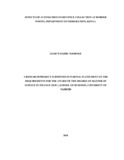| dc.description.abstract | Revenue collection is an important activity for all organizations (Edem, 2017). Revenue denotes the inflows that make the achievement of organization objectives possible. Automation of revenue collection system focuses on putting resources into current innovations for instance: ICT with the end goal to redesign the income framework to accomplish joining and data partaking in order to improve proficiency and adequacy of the framework.The Department of immigration instituted automation of its process in the year 2015 following the enactment of the e-citizen program. Preliminary data reveals wide deviations in the total revenue collected (Immigration Department, 2018). The deviations are observed across the 35 border points, with some border points revealing high revenue (JKIA year 2017/2018=kes 1.246B) while other shows negligible revenue (For instance, Muhuru Bay year 2017/2-18=kes 34,300). Therefore, this study sought to determine to determine the effect of automation on revenue collection by border points under the Department of Immigration, Kenya. The study applied explanatory research to explain how one variable (the dependent variable) is influenced by a set of independent variables. The study used an event study approach. The study applied t-test analysis check whether revenues spanning 3 years before automation were significantly different from revenues collected in the 3 years following automation. The point of reference is year 2015. The study population involved the 35 operational border points under the department of immigration, Kenya. Secondary dataset was analyzed using SPSS software. Quantitative data analysis techniques including descriptive and inferential statistics were used. The particular descriptive statistics include means and standard deviations. The inferential statistics include t-test, correlation and multiple linear regression analysis. The independent t-test findings revealed that there was significance difference in total revenue collected between the period before automation year and period after automation years. Additionally, the regression results revealed positive and significant relationship between the independent and dependent variables. Based on the findings, the study concluded that automation on revenue collection at border points and positive and significant impact on the total revenue collected. This was shown by the sharp increasing trend of amount of revenue collected after automation, 2015 being the reference year. The study recommended that future studies to conduct event studies on automation in other departments and government agencies for the purpose of comparison of findings. | en_US |



